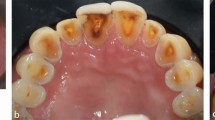Abstract
Various techniques are available for the application of composite to restore worn teeth. Different techniques may be chosen based on the clinical presentation or clinician preference. However, for composite to be successful, there are numerous factors which must be considered in order to optimise the outcome. Pre-treatment steps, such as isolation for optimal moisture control and adequate surface preparation of the tooth, as well as the post build-up objectives of achieving a stable occlusion, good marginal adaptation and final aesthetics, are discussed in the paper.
Key points
-
Composite can be used to restore teeth using the free-hand technique, free-hand technique with a palatal stent, or full coverage matrix techniques. Each method has advantages and disadvantages which are discussed.
-
Optimal surface preparation of the teeth for restoration, adequate isolation to ensure good moisture control, sufficient thickness of composite and a stable occlusion post restoration are key considerations to successful composite restorations.
-
Multiple appointments are generally required in the restoration of tooth wear patients when using composite. Having consecutive appointments allows the clinician sufficient time to ensure restorations are well-contoured and polished to optimise the aesthetics but also review the occlusal scheme and make necessary adjustments.
This is a preview of subscription content, access via your institution
Access options
Subscribe to this journal
Receive 24 print issues and online access
$259.00 per year
only $10.79 per issue
Buy this article
- Purchase on Springer Link
- Instant access to full article PDF
Prices may be subject to local taxes which are calculated during checkout







Similar content being viewed by others
References
Aminian A, Leven A J, Ashley M P. Indications for the use of direct composite restorations in the management of tooth wear. Br Dent J 2023; 234: 395-399.
Mehta S B, Banerji S, Millar B J, Suarez-Feito J-M. Current concepts on the management of tooth wear: part 4. An overview of the restorative techniques and dental materials commonly applied for the management of tooth wear. Br Dent J 2012; 212: 169-177.
Tiwari B, Ladha K, Lalit A, Dwarakananda Naik B. Occlusal concepts in full mouth rehabilitation: an overview. J Indian Prosthodont Soc 2014; 14: 344-351.
Mehta S B, Banerji S, Millar B J, Suarez-Feito J M. Current concepts on the management of tooth wear: part 3. Active restorative care 2: the management of generalised tooth wear. Br Dent J 2012; 212: 121-127.
Spear F. The maxillary central incisal edge: a key to esthetic and functional treatment planning. Compend Contin Educ Dent 1999; 20: 512-516.
Jafri Z, Ahmad N, Sawai M, Sultan N, Bhardwaj A. Digital Smile Design - An innovative tool in aesthetic dentistry. J Oral Biol Craniofac Res 2020; 10: 194-198.
Vig R G, Brundo G C. The kinetics of anterior tooth display. J Prosthet Dent 1978; 39: 502-504.
Sabri R. The eight components of a balanced smile. J Clin Orthod 2005; 39: 155-167.
Lu H, Yoshinaga T, Li C, Nozaki K, Iida A, Tsubokura M. Numerical investigation of effects of incisor angle on production of sibilant /s/. Sci Rep 2021; 11: 16720.
Poojary P K, Bhandary S, Srinivasan R, Nasreen F, Pramod J, Mahesh M. Influence of restorative technique, Bevelling and aging on composite bonding to sectioned incisal edges: A comparative in vitro study. J Conserv Dent 2013; 16: 28-31.
Ramírez-Barrantes J C. Esthetic Anterior Resin Restorations: To Bevel Enamel or Not? Odovtos Int J Dent Sci 2019; 23: 27-31.
Sinjari B, Santilli M, D'Addazio G et al. Influence of Dentine Pre-Treatment by Sandblasting with Aluminium Oxide in Adhesive Restorations. An In Vitro Study. Materials (Basel) 2020; 13: 3026.
Zhang L, Yu P, Wang X-Y. Surface roughness and gloss of polished nanofilled and nanohybrid resin composites. J Dent Sci 2021; 16: 1198-1203.
Poyser N, Porter R, Briggs P, Kelleher M. Demolition experts: management of the parafunctional patient: 2. Restorative management strategies. Dent Update 2007; 34: 262-268.
Raskin R, Setcos J C, Vreven J, Wilson N H. Influence of the isolation method on the 10-year clinical behaviour of posterior resin composite restorations. Clin Oral Investig 2000; 4: 148-152.
Robinson S, Nixon P J, Gahan M J, Chan M F W Y. Techniques for restoring worn anterior teeth with direct composite resin. Dent Update 2008; 35: 551-558.
Mehta S B, Francis S, Banerji S. A Guided, Conservative Approach for the Management of Localized Mandibular Anterior Tooth Wear. Dent Update 2016; 43: 106-112.
Bailey O, McGuirk C, O'Connor C. Matrix transfer techniques for direct paste composite resins. Br Dent J 2022; 233: 91-98.
Dietschi D. Free-hand composite resin restorations: a key to anterior aesthetics. Pract Periodontics Aesthet Dent 1995; 7: 15-25.
Panchal A C, Asthana G. Oxygen inhibition layer: A dilemma to be solved. J Conserv Dent 2020; 23: 254-258.
Gulamali A B, Haemmings K W, Tredwin C J, Petrie A. Survival analysis of composite Dahl restorations provided to manage localised anterior tooth wear (ten year follow-up). Br Dent J 2011; DOI: 10.1038/sj.bdj.2011.683.
Blum I R, Lynch C D, Wilson N H. Factors influencing repair of dental restorations with resin composite. Clin Cosmet Investig Dent 2014; 6: 81-87.
Leven A J, Némat S M. Presentation and management of mandibular anterior tooth wear. Dent Update 2022; 49: 569-574.
Poyser N J, Briggs P F A, Chana H S, Kelleher M G D, Porter R W J, Patel M M. The evaluation of direct composite restorations for the worn mandibular anterior dentition - clinical performance and patient satisfaction. J Oral Rehabil 2007; 34: 361-376.
Author information
Authors and Affiliations
Contributions
Amin Aminian is the main author, with support and contribution from A. Johanna Leven and Martin Ashley. All three authors contributed to the concept, the design, the writing and the editing.
Corresponding author
Ethics declarations
The authors declare that there are no conflicts of interest.
Rights and permissions
About this article
Cite this article
Aminian, A., Leven, A. & Ashley, M. Clinical considerations in the application of direct composite for tooth wear. Br Dent J 234, 400–405 (2023). https://doi.org/10.1038/s41415-023-5675-2
Received:
Revised:
Accepted:
Published:
Issue Date:
DOI: https://doi.org/10.1038/s41415-023-5675-2



